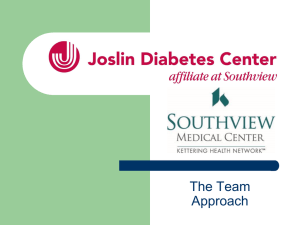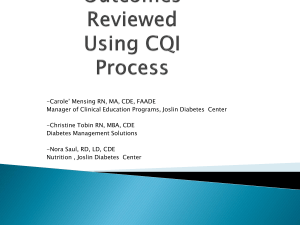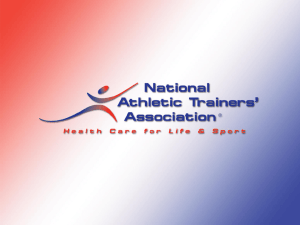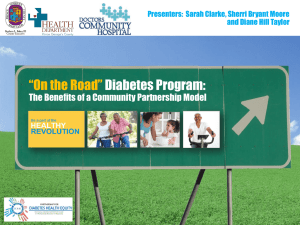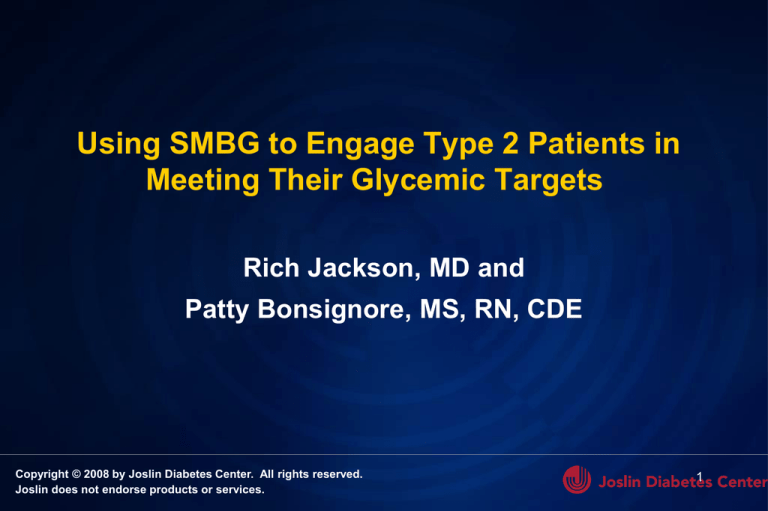
Using SMBG to Engage Type 2 Patients in
Meeting Their Glycemic Targets
Rich Jackson, MD and
Patty Bonsignore, MS, RN, CDE
Copyright © 2008 by Joslin Diabetes Center. All rights reserved.
Joslin does not endorse products or services.
1
Overview
Purpose of program
• Making efficient use of Self-Monitoring Blood Glucose (SMBG)
Tools
• SMBG
• Pattern analysis
Outcomes
• Engagement of patient
• Efficient approach to controlling glycemia
• Improved glycemic results
– Better A1C
– No hypoglycemia
Copyright © 2008 by Joslin Diabetes Center. All rights reserved.
Joslin does not endorse products or services.
We Are NOT At Goal
Only 7% of adults with diabetes in
NHANES 1999-2000 attained:
• A1C level <7%
• Blood pressure <130/80 mm Hg
GOAL Survey
•
100
% of Subjects
n = 404
80
60
12.4%
7.8%
63%
7%
A1C
37.2%
>8%
17.0%
25.8%
>10%
>9%
>8%
7-8%
40
20
Total cholesterol <200 mg/dL
37.0%
Adults aged 20-74 years with previously
diagnosed diabetes who participated in the
interview and examination components of
the National Health Examination Survey
(NHANES), 1999-2000.
<7%
0
Saydah SH et al. JAMA. 2004;291:335-342.
Copyright © 2008 by Joslin Diabetes Center. All rights reserved.
Joslin does not endorse products or services.
3
Copyright © 2008 by Joslin Diabetes Center. All rights reserved.
Joslin does not endorse products or services.
Back to Basics – Just Say “AHH”
1. A1C and average blood glucose
• On target? (Do patients know their target?)
2. Hypoglycemia (<70 mg/dL)
• Fasting or postprandial?
• Frequent or intermittent?
• Symptoms?
3. Hyperglycemia (>fasting/postprandial target)
• Fasting or postprandial?
• Frequent or intermittent?
Copyright © 2008 by Joslin Diabetes Center. All rights reserved.
Joslin does not endorse products or services.
5
What’s Involved …
• Data collection → Utilize A1C and SMBG Profiles
• SMBG and Pattern Analysis → Provide framework for
an informed treatment plan
• Patient and Provider Actions → Initiate and support
effective communication/counseling
• Cycling → Use ongoing review of SMBG to adjust
therapy more frequently when patient not meeting
goal
Copyright © 2008 by Joslin Diabetes Center. All rights reserved.
Joslin does not endorse products or services.
Pattern Analysis to
Show Patients the
Importance of SMBG
Copyright © 2008 by Joslin Diabetes Center. All rights reserved.
Joslin does not endorse products or services.
Harry O
• 53 year old male wit h 12 years of type 2 diabetes
• A1C - 7.8 NOT AT TARGET
• On metformin, long-acting basal insulin
• Had frequent mild hyperglycemia during much of
the day
• Because of frequent highs, he kept gradually
increasing his long-acting basal insulin
Harry agrees to do 3 weeks of “intensive”
SMBG
Copyright © 2008 by Joslin Diabetes Center. All rights reserved.
Joslin does not endorse products or services.
What you say: “Thank you, Harry. You’ve
provided some really good information.”
What you think: “Where is the pattern?”
Copyright © 2008 by Joslin Diabetes Center. All rights reserved.
Joslin does not endorse products or services.
SMBG Pattern Analysis
facilitates identification of problem areas and timing
Logbook
• Paper
• Software
Pie charts
Trend graph
Modal Day
Copyright © 2008 by Joslin Diabetes Center. All rights reserved.
Joslin does not endorse products or services.
Logbook
• Remains useful for many people
• Time and date need to be
accurately set
• Useful for block-checking
• Useful when reviewing with
patient, as it tells a story about
food or activity changes
• NOTE: encourage patients to
continue to use handwritten
logbook to capture information
for discussion during visit
Copyright © 2008 by Joslin Diabetes Center. All rights reserved.
Joslin does not endorse products or services.
11
Pie Charts
• Can show values for all
times
• Can also focus on
values at specific times
• Pre- and post-meal
• Useful for honing in on
specific times of
hypoglycemia
• Helpful in conjunction
with modal (standard)
day
Copyright © 2008 by Joslin Diabetes Center. All rights reserved.
Joslin does not endorse products or services.
12
Trend Graph
• Shows glucose values over
extended periods of time
• Can identify longer-term trends
not seen in other charts
• Improvements
• Weekends vs weekdays
• Highlighted or shaded to show
overall ranges of values
• Not as helpful at identifying
times of day that are outliers
Copyright © 2008 by Joslin Diabetes Center. All rights reserved.
Joslin does not endorse products or services.
Modal Day
• Each graph represents
distribution of glucoses at a
particular time of day
• Shows where majority of
numbers fall
• Also shows maximum and
minimum
• Useful for identifying
patterns of hyperglycemia
and hypoglycemia
Copyright © 2008 by Joslin Diabetes Center. All rights reserved.
Joslin does not endorse products or services.
Effects of Meals and Snacks –
Carbohydrates
• Significance
• Big effect on postprandial glucose values
• Amounts – portion size
– Initial diets often targeted at 45-60 grams/meal
• Glycemic index
– Foods with LOWER glycemic index produce LOWER postprandials
• Fiber
– Lowers glycemic impact of meal, and is heart-healthy
• Don’t forget, sugar-free foods are usually not carb-
free
Copyright © 2008 by Joslin Diabetes Center. All rights reserved.
Joslin does not endorse products or services.
15
High – Moderate – Low GI Foods
Food
Glycemic Index
Glucose
Potato, baked
Cornflakes
Bread, white
Watermelon
Rice, white
Oatmeal
Banana
Snickers Bar
Carrots, cooked
Pasta, spaghetti
Kidney beans
Apple
M & Ms, peanuts
Peanuts
Foster-Powell, K. AJCN, 2002
Copyright © 2008 by Joslin Diabetes Center. All rights reserved.
Joslin does not endorse products or services.
100
85
81
73
72
64
58
55
55
49
41
28
38
33
14
High 70
Moderate =
56 – 69
Low 55
Effects of Meals and Snacks - Fats
• Dietary fat
• Delays carbohydrate absorption
• High-fat meals associated with delayed hyperglycemia
• Up to 4-8 hours later
• Pizza, Pad Thai , cheeseburgers are classic examples
• Fats should also be heart-healthy
• Mono and poly-unsaturated
• Reduce saturated fats
• Avoid trans-fats
Copyright © 2008 by Joslin Diabetes Center. All rights reserved.
Joslin does not endorse products or services.
Effects of Meals and Snacks
• Dietary fiber
• Targets of 25-50 grams/day
– Can be difficult to achieve
• Improves postprandial numbers for some
• Soluble fiber can lower cholesterol numbers
• Increases satiety
• Alcohol
• Can cause hypoglycemia, especially when taken without
carbohydrates
• Don’t forget, it’s a source of calories
• Moderate intake associated with improved heart health
Copyright © 2008 by Joslin Diabetes Center. All rights reserved.
Joslin does not endorse products or services.
Effects of Physical Activity on Glucose
Metabolism
• Immediate effects
• During and several hours after exercise
• Delayed effects
• 4 – 12 hours after exercise
• Long-lasting effects
• Improves insulin sensitivity
• Implications for glucose monitoring
Copyright © 2008 by Joslin Diabetes Center. All rights reserved.
Joslin does not endorse products or services.
Hypoglycemia Treatment Options
• Frequent
• Decrease medication
– Usually sulfonylurea or insulin
– Special problems associated with SU
• Intermittent
• Due to too little food
– Adjust food
– Decrease insulin dose if on insulin
• Due to too much physical activity
– Add carbs for extra fuel
– Decrease insulin dose if on insulin
Copyright © 2008 by Joslin Diabetes Center. All rights reserved.
Joslin does not endorse products or services.
Hyperglycemia Treatment Options
• Reduce food portions and/or carbohydrates
• Add in aerobic physical activity
• Resistance exercise adds benefit also
• Increase medication effect
• Dosage, timing
• Add new medication
Copyright © 2008 by Joslin Diabetes Center. All rights reserved.
Joslin does not endorse products or services.
Putting It All Together
Copyright © 2008 by Joslin Diabetes Center. All rights reserved.
Joslin does not endorse products or services.
SMBG -- Listening to Your Patient
• Collect the information
• Thank them for bringing it in
• Ask what they think about their numbers
• Look for barriers to checking glucoses
• Ask if you could share some of your thoughts on
their numbers
• Give a brief interpretation
• Using AHH, emphasize average glucose goal and A1C
• Decide, with the patient, about an approach to take
• Changing food, activity, medication
• Discuss follow-up
Copyright © 2008 by Joslin Diabetes Center. All rights reserved.
Joslin does not endorse products or services.
The Basics – Just Say AHH
• A1C and average blood glucose
• On target? (Do they know their target?)
• Hypoglycemia (<70 mg/dL)
• Fasting or postprandial?
• Frequent or intermittent?
• Symptoms?
• Hyperglycemia (>fasting/postprandial target)
• Fasting or postprandial?
• Frequent or intermittent?
Copyright © 2008 by Joslin Diabetes Center. All rights reserved.
Joslin does not endorse products or services.
Explain Relationship Between A1C and
estimated Average Glucose (eAG)
Helps “translate”
A1C into language
patients understand
… makes goals
more tangible
eAG = 28.7*A1C – 46.7
Nathan et al, Diabetes Care 2008 31:1-6
A1C (%)
eAG mg/dl (95% CI)
12
298 (240-347)
11
269 (217-314)
10
240 (193-282)
9
212 (170-249)
8
183 (147-217)
7
154 (123-185)
6
126 (100-152)
5
97 (76-120)
4
68 (51-86)
Copyright © 2008 by Joslin Diabetes Center. All rights reserved.
Joslin does not endorse products or services.
AHH – First Step
A1C and Average Blood Glucose
• Having recent A1C result is best
• Within last month
– Half of A1C value is derived from glucoses from last 30 days
• Consider Point of Care testing
• Studies show that having A1C result before visit improves future
A1C by about 1 point
• Using average from meter, use eAG to convert to
approximate A1C
• Average glucose of 154 corresponds to A1C of 7.0
• Make sure patient knows A1C target, and last result
Copyright © 2008 by Joslin Diabetes Center. All rights reserved.
Joslin does not endorse products or services.
What the A1C doesn’t tell you, but SMBG
does
• Identifies hypoglycemia
• Dynamic relationship between insulin,
carbohydrates, physical activity and resulting
glucose level
• Effects of different meals and snacks
• Effects of physical activity
• Effects of medications
Copyright © 2008 by Joslin Diabetes Center. All rights reserved.
Joslin does not endorse products or services.
Explaining the Numbers
• Begin and end each visit with
discussion of the A1C
Timing
Glucose goal
(mg/dl)
Fasting or
preprandial
70-130
2-3 hour
postprandial
<180
Before bed
90-150
• Make sure patients know their A1C
targets and glucose goals
• Explain importance of SMBG
to determine action points
• Changes in glucose average
• Hypoglycemia
• Hyperglycemia
• Importance of accurate meter
date and time, especially with
multiple meters
Joslin Diabetes Center Clinical Guidelines
www.joslin.org
Copyright © 2008 by Joslin Diabetes Center. All rights reserved.
Joslin does not endorse products or services.
AHH – Second Step
Choose Your Preferred View to Look for Hypoglycemia
• Identify frequency of
hypoglycemia
• % below target
• Identify timing of hypoglycemia
• Modal (standard) day
• Trend chart
• Pie charts by
time frame
Copyright © 2008 by Joslin Diabetes Center. All rights reserved.
Joslin does not endorse products or services.
AHH – Second Step
Look for hypoglycemia
• Remember, patient may not have
hypoglycemia documented
• In addition to meter results, ask patient about
symptoms, time and frequency of occurrence
• Indices like Low Blood Glucose Index (LBGI)
can identify risk for severe hypoglycemia in
near future
Copyright © 2008 by Joslin Diabetes Center. All rights reserved.
Joslin does not endorse products or services.
Hypoglycemia
Frequent or Intermittent?
• Frequent
• Occurring most days
• Usually at the same time
• Predictable by patient
• Intermittent
• Different days
• Different times
• Often surprises patient
Copyright © 2008 by Joslin Diabetes Center. All rights reserved.
Joslin does not endorse products or services.
AHH – Third Step
Look for Hyperglycemia
• If A1C above target, hyperglycemia present by
definition
• Identify frequency of above-target glucose results
• % above target
• Identify timing of hyperglycemia
• Modal (standard) day
• Trend chart
• Pie charts by time frame
• HBGI can identify risk for future marked hyperglycemia
Copyright © 2008 by Joslin Diabetes Center. All rights reserved.
Joslin does not endorse products or services.
Approach to Hyperglycemia
• Based on A1C
• When A1C is above target, hyperglycemia is present
somewhere
• Identify areas of hyperglycemia
• Numbers over 180 initially
• Any numbers over targets
• Start with fasting numbers
• If SMBG data looks reasonable, but A1C is high
• Need to target increased glucose checks at times not
currently done
Copyright © 2008 by Joslin Diabetes Center. All rights reserved.
Joslin does not endorse products or services.
Treat the Fasting …
Copyright © 2008 by Joslin Diabetes Center. All rights reserved.
Joslin does not endorse products or services.
Then treat the postprandial …
Copyright © 2008 by Joslin Diabetes Center. All rights reserved.
Joslin does not endorse products or services.
The Basics – Just Say AHH
• A1C and average blood glucose
• On target? (Do they know their target?)
• Hypoglycemia (<70 mg/dL)
• Fasting or postprandial?
• Frequent or intermittent?
• Symptoms?
• Hyperglycemia (>fasting/postprandial target)
• Fasting or postprandial?
• Frequent or intermittent?
Copyright © 2008 by Joslin Diabetes Center. All rights reserved.
Joslin does not endorse products or services.
Cycling …
• Data collection → Utilize A1C and SMBG Profiles
• Data Visualization and Analysis → Provides
framework for an informed treatment plan
• Patient and Provider Actions → Initiate
therapeutic interventions based on data analysis
• Cycling → Use ongoing review of SMBG to adjust
therapy more frequently when patient not meeting
goal
Copyright © 2008 by Joslin Diabetes Center. All rights reserved.
Joslin does not endorse products or services.
Keep Cycling
Copyright © 2008 by Joslin Diabetes Center. All rights reserved.
Joslin does not endorse products or services.
CASES
Copyright © 2008 by Joslin Diabetes Center. All rights reserved.
Joslin does not endorse products or services.
Hypoglycemia
Fasting, intermittent
Copyright © 2008 by Joslin Diabetes Center. All rights reserved.
Joslin does not endorse products or services.
Margaret S
• 51 year old female with type 2 diabetes 4 years
• A1C – 7.4
• Metformin 850 mg twice a day, glipizide 10 mg
twice a day
• Has been trying to lose weight, and has had some
success
• Has been more careful with portion sizes
• Uses home treadmill after supper several days/week,
goes to morning aerobics class twice a week
Copyright © 2008 by Joslin Diabetes Center. All rights reserved.
Joslin does not endorse products or services.
Patterns in fasting hypoglycemia –
– intermittent
Copyright © 2008 by Joslin Diabetes Center. All rights reserved.
Joslin does not endorse products or services.
Margaret S
Patterns in fasting hypoglycemia –
– intermittent
Average glucose = 167
Copyright © 2008 by Joslin Diabetes Center. All rights reserved.
Joslin does not endorse products or services.
Margaret S
Intermittent fasting hypoglycemia –
– diagnostic approach
Margaret S
If fasting glucose is intermittently low-low/normal,
find the cause. Is it related to variability in:
• bedtime glucose (Do morning lows follow bedtime lows
or bedtime highs?)
• evening snacking
• physical activity
• insulin/medication
• alcohol intake
Recommend that the patient keep targeted records
about food intake, physical activity, medication use
Copyright © 2008 by Joslin Diabetes Center. All rights reserved.
Joslin does not endorse products or services.
Margaret S – the rest of the story
• Review of her meter averages shows that her one month
average is 152, and her 90 day average is 171
• Review of her results also showed that the fasting
hypoglycemia was almost always preceded by exercise the
night before.
• Her exercise, combined with her other lifestyle changes, had improved her
glucose values (glucose average coming down)
• On nights when she exercised in the evening, the exercise effect lowered her
glucoses, resulting in the morning hypoglycemia
• Margaret cut back her glipizide to 10 mg in the morning only,
and continued to work on her diet and physical activity. She
had no further hypoglycemia during the next week.
Copyright © 2008 by Joslin Diabetes Center. All rights reserved.
Joslin does not endorse products or services.
Future approach
Margaret S
• SMBG recommendations
• Possibility of further exercise-related hypoglycemia
– Check post-exercise
Also pre-lunch on days with morning aerobics
Also pre-bedtime on nights when she used treadmill
• She should return in one month to make sure that
her A1C is continuing to improve
• During this time, she can follow her meter glucose
averages to make sure that her average is continuing in
the 152 range
Copyright © 2008 by Joslin Diabetes Center. All rights reserved.
Joslin does not endorse products or services.
— continued
Margaret S
If she continues to progress with her lifestyle
changes, she may experience hypoglycemia again
• If this occurs, she could reduce or discontinue her glipizide
• If reducing the glipizide removes hypoglycemia, but her A1C remains
above target, then further medication changes might be needed
– Increasing metformin to 850 three times a day
– Adding a TZD
– Exenatide could be a good choice here, especially as she is interested
in losing weight
– Basal insulin
– DPP-IV inhibitor less effective, more expensive, shorter clinical
experience concerning side effects and adverse events
Copyright © 2008 by Joslin Diabetes Center. All rights reserved.
Joslin does not endorse products or services.
Post-prandial hypoglycemia – frequent
Margaret S
Copyright © 2008 by Joslin Diabetes Center. All rights reserved.
Joslin does not endorse products or services.
Patterns in postprandial hypoglycemia –
– frequent
Margaret S
Average glucose = 148
Copyright © 2008 by Joslin Diabetes Center. All rights reserved.
Joslin does not endorse products or services.
Patterns in postprandial hypoglycemia –
– frequent
Margaret S
Copyright © 2008 by Joslin Diabetes Center. All rights reserved.
Joslin does not endorse products or services.
Patterns in postprandial hypoglycemia –
frequent
Margaret S
Copyright © 2008 by Joslin Diabetes Center. All rights reserved.
Joslin does not endorse products or services.
Hypoglycemia
Postprandial, Intermittent
Copyright © 2008 by Joslin Diabetes Center. All rights reserved.
Joslin does not endorse products or services.
Clayton V
• 68 year old retired military officer with type 2 diabetes
for 5 years.
• A1C – 6.8
• Metformin 500mg twice a day, glimeperide 4 mg/day
• Relatively inactive, diet stable
Copyright © 2008 by Joslin Diabetes Center. All rights reserved.
Joslin does not endorse products or services.
Postprandial hypoglycemia –
– intermittent
Copyright © 2008 by Joslin Diabetes Center. All rights reserved.
Joslin does not endorse products or services.
Clayton V
Patterns in postprandial hypoglycemia –
– intermittent
Clayton V
Average glucose = 147
Copyright © 2008 by Joslin Diabetes Center. All rights reserved.
Joslin does not endorse products or services.
Patterns in postprandial hypoglycemia –
– intermittent
Clayton V
Copyright © 2008 by Joslin Diabetes Center. All rights reserved.
Joslin does not endorse products or services.
Patterns in postprandial hypoglycemia –
– intermittent
Clayton V
Copyright © 2008 by Joslin Diabetes Center. All rights reserved.
Joslin does not endorse products or services.
Intermittent postprandial hypoglycemia –
– diagnostic approach
Clayton V
If postprandial glucose is intermittently lowlow/normal, find the cause. Is it related to variability in:
•
•
•
•
food intake
physical activity
insulin/medication
alcohol intake
Recommend that the patient keep targeted records
about food intake, physical activity, medication use
Copyright © 2008 by Joslin Diabetes Center. All rights reserved.
Joslin does not endorse products or services.
Clayton V – the rest of the story
• More detailed history reveals afternoon whiskeys
several times a week
• Most hypoglycemia was occurring pre-dinner, post
whiskey
• Added carbohydrate snacks to afternoon cocktails,
with resolution of hypoglycemic episodes
Copyright © 2008 by Joslin Diabetes Center. All rights reserved.
Joslin does not endorse products or services.
Future approach
Clayton V
• SMBG recommendations
• Include post-alcohol glucose checks
• Check pie charts, % hypoglycemia reports for presence
of hypoglycemia
• If any further hypoglycemia, consider reducing or
stopping glimeperide and increasing metformin.
• Metformin a concern, however, if liver dysfunction
or alcohol abuse is present
• Liver function tests
• Careful alcohol history
Copyright © 2008 by Joslin Diabetes Center. All rights reserved.
Joslin does not endorse products or services.
Hypoglycemia therapeutic options – food
Clayton V
• Missed or delayed meal
• Meal lower than usual in carbohydrates
• If on bolus insulin
• Consider insulin: carbohydrate ratio
• If on sulfonylurea or related medication
• Consider switch to other oral agent if irregular meals
likely to continue
• Consider quick meal replacements for occasional
use, such as bars…
Copyright © 2008 by Joslin Diabetes Center. All rights reserved.
Joslin does not endorse products or services.
Hypoglycemia therapeutic options –
physical activity
Clayton V
• Important not to discourage physical activity
• If on bolus insulin, and physical activity within about 3
hours after bolus, can decrease the bolus prospectively
• If schedule allows, could move physical activity closer to
meal
• Otherwise, need to add fuel before, and possibly during,
physical activity
• Occasional lag effect, where glucose remains low for more
than four hours after physical activity
Copyright © 2008 by Joslin Diabetes Center. All rights reserved.
Joslin does not endorse products or services.
Hypoglycemia therapeutic options –
medication
Clayton V
• Bolus insulin
• Can be reduced if food or activity changes are planned
• Basal insulin
• Can be reduced if fasting hypoglycemia, or if
hypoglycemia is occurring at multiple times
• Sulfonlyureas and related meds
• If hypoglycemia frequent, consider switching to other oral
med if possible
Copyright © 2008 by Joslin Diabetes Center. All rights reserved.
Joslin does not endorse products or services.
Checking for hyperglycemia
Clayton V
• Once hypoglycemia has been addressed:
• Reassess A1C goal and current result
• If A1C is on target, and hypoglycemia is rare, no urgent need
to assess hyperglycemia
• If A1C is above target, begin to look for hyperglycemic
patterns
Copyright © 2008 by Joslin Diabetes Center. All rights reserved.
Joslin does not endorse products or services.
Hyperglycemia fasting vs. postprandial
Clayton V
• Start with fasting
• If high, determine bedtime glucose
– If bedtime in same range as fasting
Focus on improving bedtime number
– If bedtime is in reasonable range
Focus on improving fasting number
– If bedtime numbers not available, plan to acquire them
• If fasting reasonable, examine or acquire post-prandial or
pre-meal values
Copyright © 2008 by Joslin Diabetes Center. All rights reserved.
Joslin does not endorse products or services.
Hyperglycemia
Fasting, Frequent
Copyright © 2008 by Joslin Diabetes Center. All rights reserved.
Joslin does not endorse products or services.
Josh H
• 58 year old male with type 2 diabetes 9 years
• A1C – 8.2
• Metformin 850 mg three times a day, glipizide 10
mg twice a day
• Last year A1Cs were around seven
Copyright © 2008 by Joslin Diabetes Center. All rights reserved.
Joslin does not endorse products or services.
Fasting hyperglycemia frequent
Josh H
Copyright © 2008 by Joslin Diabetes Center. All rights reserved.
Joslin does not endorse products or services.
Fasting hyperglycemia – frequent
Josh H
Average glucose = 193
Copyright © 2008 by Joslin Diabetes Center. All rights reserved.
Joslin does not endorse products or services.
Fasting hyperglycemia – frequent
Josh H
Copyright © 2008 by Joslin Diabetes Center. All rights reserved.
Joslin does not endorse products or services.
Fasting hyperglycemia – frequent
Josh H
Copyright © 2008 by Joslin Diabetes Center. All rights reserved.
Joslin does not endorse products or services.
Frequent fasting hyperglycemia –
– diagnostic approach
Josh H
If fasting glucose is frequently high and also higher
than at bedtime, treat accordingly:
Insufficient medication/insulin: determine which
medication targets hepatic glucose production;
check dose and compliance of patient
Excessive bedtime snacking: discuss evening
eating habits with patient
Rebound fasting highs: check to see if patient is
having symptoms of hypoglycemia
•
May need to check 2 am – 4 am glucose
Copyright © 2008 by Joslin Diabetes Center. All rights reserved.
Joslin does not endorse products or services.
Josh H – the rest of the story
• Diet and physical activity were stable
• A1C gradually rising during last year
• Modal (Standard) day , pie charts show fasting
numbers as highest of the day.
• Basal insulin at bedtime started, titrated to fasting
glucose of around 100
• Glipizide stopped
• Metformin continued, although stopping is also an option
Copyright © 2008 by Joslin Diabetes Center. All rights reserved.
Joslin does not endorse products or services.
Future approach
Josh H
• SMBG recommendations
• Focus on fasting glucose initially, and keep titrating basal
insulin (glargine, levemir, NPH) until fasting around 100 or less
• After fasting target reached, reassess glucose average, A1C
• Return to clinic one month to review progress
• Because A1C was 8.2, there may be need in near future
for prandial insulin
• Check post-prandial or pre-meal and bedtime glucose
• Use Modal day (Standard day) and pie charts to identify areas
of most frequent hyperglycemia
Copyright © 2008 by Joslin Diabetes Center. All rights reserved.
Joslin does not endorse products or services.
Hyperglycemia
Post-prandial, intermittent
Copyright © 2008 by Joslin Diabetes Center. All rights reserved.
Joslin does not endorse products or services.
Nate W
• 48 year old male with type 2 diabetes 4 years
• A1C – 7.1
• Metformin 500 mg twice a day
• Exercises regularly
• Has recently become a vegetarian
Copyright © 2008 by Joslin Diabetes Center. All rights reserved.
Joslin does not endorse products or services.
Post-prandial hyperglycemia –
– Intermittent
Nate W
Copyright © 2008 by Joslin Diabetes Center. All rights reserved.
Joslin does not endorse products or services.
Post-prandial hyperglycemia –
-- intermittent
Average glucose = 164
Copyright © 2008 by Joslin Diabetes Center. All rights reserved.
Joslin does not endorse products or services.
Nate W
Post-prandial hyperglycemia –
– intermittent
Nate W
Copyright © 2008 by Joslin Diabetes Center. All rights reserved.
Joslin does not endorse products or services.
Post-prandial hyperglycemia –
– intermittent
Nate W
Copyright © 2008 by Joslin Diabetes Center. All rights reserved.
Joslin does not endorse products or services.
Post-prandial hyperglycemia –
– treatment approach
Nate W
• Food
• Consider lower glycemic index foods
• Look at portion size
• Consider carb total
• Medication
• Consider prandial meds
• AGI, meglitinides, D-phenyalanine derivatives, DPP-IV inhibitor
• Bolus insulin, alone or mixed
• Incretin mimetic
• Physical activity
• Consider moving or adding exercise to balance effect
Copyright © 2008 by Joslin Diabetes Center. All rights reserved.
Joslin does not endorse products or services.
Nate W – the rest of the story
• Pie chart and Modal (Standard) day show that hyperglycemia
is most frequent after lunch and supper
• Trend graph shows no clear pattern by day
• Diet review reveals that since becoming vegetarian,
carbohydrate intake is increased, with some meals having
large amounts of carbohydrate
• Checking post and pre-meal shows that hyperglycemia related
to high carbohydrate meals
• Referred to dietitian, and carbohydrates capped at 75
grams/meal
• Review glycemic index and fiber content of foods
Copyright © 2008 by Joslin Diabetes Center. All rights reserved.
Joslin does not endorse products or services.
Future approach
Nate W
• SMBG recommendations
• Check 3-4 post-prandial, or pre-meal and bedtime
glucose values
• Check bedtime – fasting pairs to look for fasting
hyperglycemia
• Nathaniel can use post-prandial glucose results to help
choose meals that fit with current diabetes regimen
• If A1C moves above target, consider prandial medications
• Exenatide
• Alpha-glucosidase inhibitors
• Meglitinides
Copyright © 2008 by Joslin Diabetes Center. All rights reserved.
Joslin does not endorse products or services.
Back to Basics – Just Say “AHH”
1. A1C and average blood glucose
• On target? (Do patients know their target?)
2. Hypoglycemia (<70 mg/dL)
• Fasting or postprandial?
• Frequent or intermittent?
• Symptoms?
3. Hyperglycemia (>fasting/postprandial target)
• Fasting or postprandial?
• Frequent or intermittent?
Copyright © 2008 by Joslin Diabetes Center. All rights reserved.
Joslin does not endorse products or services.
84
SMBG -- Listening to Your Patient
• Collect the information
• Thank them for bringing it in
• Ask what they think about their numbers
• Look for barriers to checking glucoses
• Ask if you could share some of your thoughts on
their numbers
• Give a brief interpretation
• Using AHH, emphasize average glucose goal and A1C
• Decide, with the patient, about an approach to take
• Changing food, activity, medication
• Discuss follow-up
Copyright © 2008 by Joslin Diabetes Center. All rights reserved.
Joslin does not endorse products or services.

